#Static HTML advantages
Explore tagged Tumblr posts
Text
WordPress vs. Static HTML: Which One is Better for Your Website?
When building a website, one of the most common dilemmas is choosing between WordPress and Static HTML. Both options offer unique advantages, and selecting the right one depends on your goals, budget, and technical expertise. In this comprehensive comparison, we’ll explore the key differences, benefits, and drawbacks of WordPress and Static HTML to help you determine the best solution for your…
#Best website platform#Choosing the right website platform#CMS vs HTML websites#Scalability in web design#Static HTML advantages#Static website pros and cons#Web development best practices#Website performance optimization#Website speed optimization#WordPress maintenance guide#WordPress security tips#WordPress SEO benefits#WordPress vs Static HTML
1 note
·
View note
Text
Top 10 Front-End Frameworks and Libraries for 2024
As the web development landscape continues to evolve, staying updated with the latest front-end frameworks and libraries is crucial for any developer. Whether you're a seasoned pro or just starting out, knowing which tools to use can significantly impact your productivity and the quality of your projects. In this post, we’ll explore the top 10 front-end frameworks and libraries that are set to dominate in 2024.
1. React
React remains one of the most popular front-end libraries, known for its simplicity and flexibility.
Key Features of React
Component-Based Architecture: Reusable components make development efficient and manageable.
Virtual DOM: Enhances performance by minimizing direct DOM manipulation.
Strong Community Support: A vast ecosystem of tools, libraries, and tutorials.
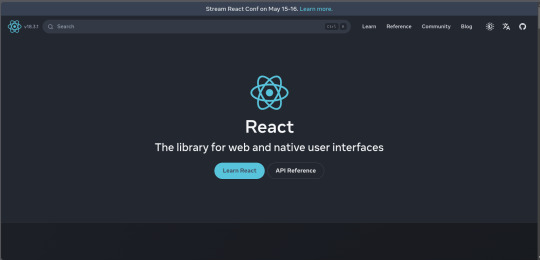
2. Angular
Angular, backed by Google, is a powerful framework for building dynamic single-page applications (SPAs).
Why Choose Angular?
Two-Way Data Binding: Synchronizes data between the model and the view.
Dependency Injection: Improves code maintainability and testability.
Comprehensive Documentation: Extensive resources for learning and troubleshooting.
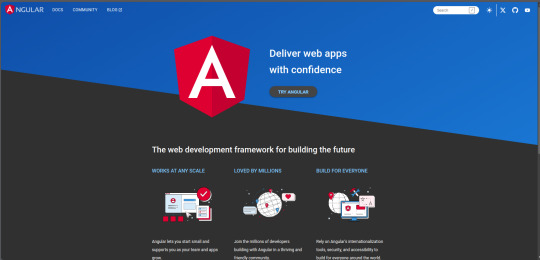
3. Vue.js
Vue.js has gained popularity due to its gentle learning curve and versatility.
Advantages of Vue.js
Reactive Data Binding: Simplifies state management.
Single-File Components: Encapsulate HTML, CSS, and JavaScript in one file.
Flexibility: Can be used for both large-scale and small-scale applications.
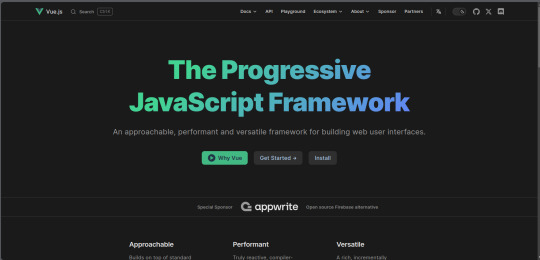
4. Svelte
Svelte is a relatively new player that compiles components into highly efficient vanilla JavaScript at build time.
Svelte’s Standout Features
No Virtual DOM: Directly manipulates the DOM for better performance.
Less Boilerplate: Cleaner code with minimal overhead.
Ease of Use: Intuitive and straightforward syntax.
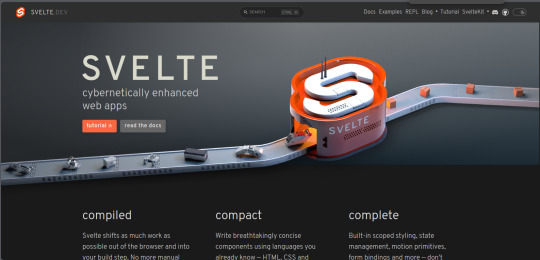
5. Bootstrap
Bootstrap is a front-end framework that provides pre-designed components and a responsive grid system.
Benefits of Using Bootstrap
Responsive Design: Ensures your site looks great on all devices.
Pre-Styled Components: Saves time with ready-to-use UI elements.
Customizable: Easily customize with Sass variables and Bootstrap’s extensive options.
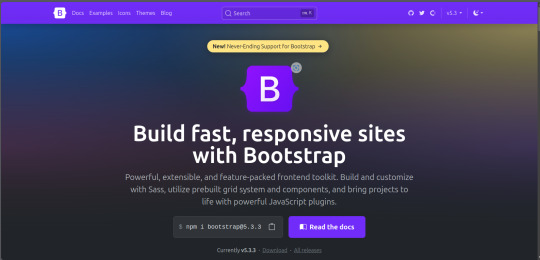
6. Tailwind CSS
Tailwind CSS is a utility-first CSS framework that allows for rapid UI development.
Tailwind CSS Features
Utility-First Approach: Use utility classes directly in your HTML.
Customizable: Extensive configuration options to suit your project’s needs.
Consistency: Enforces a consistent design language across your project.
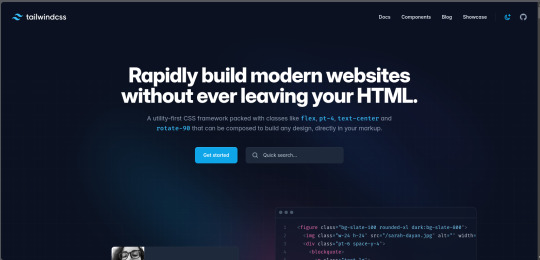
7. Ember.js
Ember.js is a robust framework for building ambitious web applications.
Why Ember.js Stands Out
Convention over Configuration: Reduces the amount of decision-making and boilerplate code.
Strong Routing: Powerful routing capabilities for managing application state.
Productivity: Focuses on developer productivity with built-in best practices.
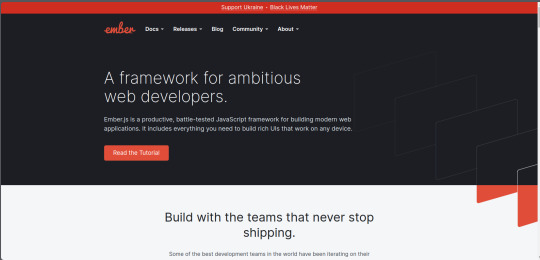
8. Alpine.js
Alpine.js offers a minimal and lightweight way to add interactivity to your websites.
Key Features of Alpine.js
Lightweight: Small footprint with only a few kilobytes.
Declarative Syntax: Similar to Vue.js, making it easy to understand and implement.
Ease of Integration: Can be easily integrated into existing projects.
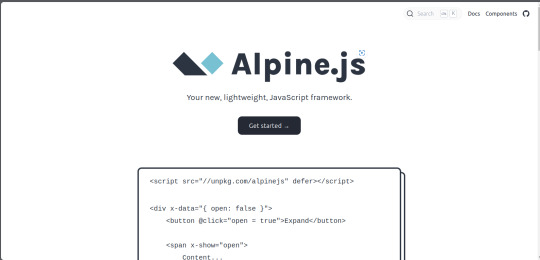
9. Next.js
Next.js is a popular React framework that enables server-side rendering and static site generation.
Benefits of Using Next.js
Server-Side Rendering (SSR): Improves performance and SEO by rendering pages on the server.
Static Site Generation (SSG): Pre-renders pages at build time for fast load times.
API Routes: Allows you to create API endpoints within your application.
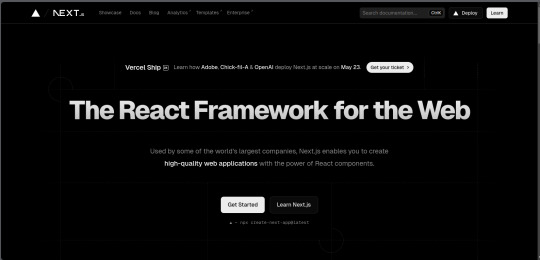
10. Lit
Lit is a simple library for building fast, lightweight web components.
Advantages of Lit
Web Components: Embraces the web components standard for reusable, encapsulated HTML elements.
Performance: Lightweight and highly performant.
Simple API: Easy to learn and use with a minimal API surface.
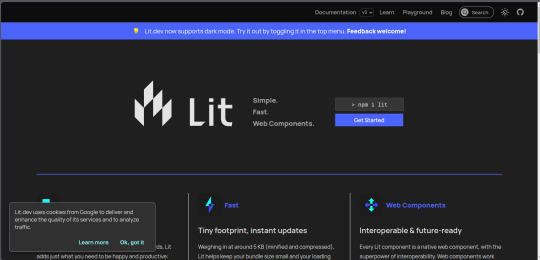
Conclusion
Choosing the right front-end framework or library can significantly impact your workflow and the quality of your projects. Whether you prefer the flexibility of React, the structure of Angular, or the simplicity of Svelte, there's a tool out there to suit your needs.
Final Tips for Selecting a Framework or Library
Project Requirements: Consider the specific needs of your project.
Community and Support: Look for frameworks with strong community support and documentation.
Learning Curve: Choose a tool that matches your current skill level and the time you have available to learn.
By staying informed about the latest tools and trends, you can ensure that your skills remain relevant and that you can deliver the best possible results in your projects. Happy coding!
Remember, the best tool is the one that helps you get the job done efficiently and effectively. So, dive into these frameworks and libraries, and take your front-end development skills to the next level!
Share Your Thoughts
I'm curious to know your thoughts on these front-end frameworks and libraries. Have you used any of them in your projects? Which one is your favorite, and why? Share your experiences and insights in the comments below.👇
2 notes
·
View notes
Text

Discover the unparalleled advantages of WordPress over Static HTML for B2B websites through seamless HTML to WordPress conversion services by HireWPGeeks. Elevate your online business with dynamic, customizable, and SEO-friendly features that WordPress offers. Experience enhanced scalability, easy content management, and superior user engagement. Transition your static site to WordPress effortlessly with our expertise and unlock the full potential of your B2B website. Make the switch today and stay ahead in the digital landscape with HireWPGeeks!
5 notes
·
View notes
Text
Predicting and programming: enemies for life (part 2)
Day 42 - Dec 17th, 12.023
This is the direct continuation of yesterday's post. I hope that I'm able to continue my daily journals as usual, but there's a strong possibility that one day or another I will not able to post, or need to post after midnight. Also, the entries probably will be shorter or just small updates sometimes even on weekends, but I will try to write them on the morning to be able to have time and brain to do something bigger and with better quality. And some posts I could even need to split into two if I need to stop writing one in the middle, like what's happened yesterday. There's no need to go into details, I don't want to expose my personal life nor of the people around me, I just want to inform that this end of year is not being great to my partner, so I want to be with her as much as I can to help and support her to whatever she needs to.
"A ghostly server"
Like I said in the last part, the application was complaining about not having a server, and the stranger, it was complaining about not having the development server running. This as a production build of the application, the embedded web-app were a static one, a static HTML file, why was it complaining about the server!? I tried searching around the Tauri's GitHub issues, but there was nothing about it, and creating an issue wasn't in my mind at the time because again, I am short in time and couldn't wait for a fix.
So because Tauri wasn't working, and I didn't even want to think about how to fix this problem, I switched back to CapacitorJS. This process was somewhat easy, because both of them are a "wrapper", so I just needed to move the web app part of the application from a template to another, but it was somewhat time-consuming (I'm not so accustomed to Vim and my new file explorer, so navigating was somewhat slower, and like every JavaScript project, just setting it up a template can be time-consuming). But after setting it up, Capacitor compiled, and the app was working as normal without any differences.
Framework hopping
While that was happening, when I started the project, I also wasted a lot of time choosing what framework to use. "Why?" One, JavaScript is an ecosystem that in general can be somewhat overwhelming with choices; Two, I already used SvelteKit for my last application and projects, so this time I wanted something different; Three, I wanted to try something more "native-like".
Web as Native
I started trying to use Framework7, because it has a collection of components and routing that emulates the native-app experience, and most important to me, it had the updated Material Design 3 (Material You) design; with Svelte, my primary UI framework of choice. But it didn't work that well. The routing wasn't how I liked it to be, and Framework7 is a somewhat old framework as it seems (it uses Gulp as its build system and the last commits were a month ago, the project is not that active), it stills a great project, but somewhat difficult to integrate with newer thing like Svelte 4 and Vite. After not being able to, I tried to KonstaUI with Svelte, but ended up with the same results. If you know something about this area of trying to make web apps feel like a native app, you are probably thinking something like "why you didn't use Ionic?", and the main reason is that it stills uses Material Design 2, and personally I like more how the newer version looks. Also, Ionic doesn't have official support for Svelte, and even knowing that the community package is good, I already used it in the past and wanted something new to try.
So, after probably hours, if not a day, trying that, I hopped into another idea. I found something called Beer CSS, a library that creates a Material You look and app using just CSS pretty much, so I could use any framework that I liked! Nonetheless, because it was pure JS and CSS, I thought it would be good to use Astro, so I could also take advantage of its new View Transitions feature, and could use Svelte still for the interactivity blocks. But as you can already tell if you know Astro, it's probably not the best idea to use a static site generator (SSG) as a mobile application framework, however it was working, and I was being able to create something and actually develop the application part of things and not just continue setting up new projects.
Lack of documentation
But then some cracks started to open. Beer CSS's documentation is not the greatest for me, it's mostly code examples and there's pretty much no words about customization and how the CSS words and/or how to manipulate it, and it seems that you really need to follow Material's system and hierarchy to it to work properly. I don't have time for this, and I already wasted 2 to 3 days fighting my way around all of this.
Also, while this was happening, the problem with Tauri also happened, which for some reason also made me switch from Astro to SvelteKit. Why? I don't know really, for me the problem with the server could be related to it, but of course it didn't work, and I had to switch to Capacitor like I said.
Blank screen and broken dreams
And then, another problem appeared out of nowhere, the built app with CapacitorJS started to have a total black screen when I opened it. There were no errors in the console, warnings on the screen, nothing, the app simply stopped working, and I couldn't find anything about it on the issues, and being honest, at this point I had already wasted around a week and couldn't handle it anymore. The idea of not being able to give at least something in time was storming my mind and I ended up wasting another day procrastinating, because I couldn't handle and think of solutions.
I had so many ideas for this app and now everything stopped working, I was exhausted, this was supposed to be something special for my girlfriend, and I don't want to lose the date again, even more now when she's passing difficult times in her life. I need to do and try something.
Compromises
This is where I am right now. I have less than a week to finish this project, and the app itself is way unfinished than I anticipated it would be days ago. So, what we do when this happens? Compromises, I already had in mind that I would create just some features until the date and then update over time, but now it will be just one feature and as an online website for now.
One of the features of this app is an interactive messaging page, to give complements and things like that, but for now I will try to repurpose it to some predefined messages and just express out of my heart to her using it. Do I want to be simple as that? No, but it only what I can do for now, and hopefully I will be able to add more things as time passes, I really want to do something special and specific for my girlfriend. Thankfully, porting it to a native app in the future won't be so hard, and I already have some ideas now on how to fix the past bugs that impossibilitaded me from porting it, however I will try to focus more on the features themselves for now.
Knowing my girlfriend, she will understand, but again, it's more of me to her thing in my mind.
---
Today's artists & creative things
Song: Hello, World - by Louie Zong I don't know why, writing this post just remembered me this music.
---
Copyright (c) 2023-present Gustavo "Guz" L. de Mello <[email protected]>
This work is licensed under the Creative Commons Attribution-ShareAlike 4.0 International (CC BY-SA 4.0) License
2 notes
·
View notes
Text
Website Designing Agency Near Me
A Dynamic Web page is a web page with web content that varies based on parameters provided by a user or a computer program. In today's world the demand for dynamic website is increasing at an alarming rate. Nowadays nearly half the websites are dynamic. Pages are no longer static HTML files but instead generated by scripts and database calls. Although dynamic websites are expensive as compared to static websites, it brings along with it numerous features and advantages.Most large company websites are dynamic, since they are easier to maintain than static websites. This is because static pages contain unique content, meaning they must be manually opened, edited, and published whenever a change is made. At initial stages, a dynamic website will give its owner the ability to update and upload new data, such as posting of news or events through simple browser interface. Dynamic websites have all the advantages over static websites. Dynamic sites are created using various languages like javascript, ajax, php, mysql, XHTML and the list goes on.

3 notes
·
View notes
Text

Edge Computing for Web Developers: How to Speed Up Your Apps
In today’s digital race, milliseconds matter.
Whether you’re building a real-time dashboard, an e-commerce platform, or a SaaS product, users expect one thing — speed. But traditional cloud setups, while powerful, aren’t always fast enough when data has to travel halfway across the globe.
Enter: Edge Computing — a game-changing strategy that moves computing closer to users and supercharges web performance.
What Is Edge Computing (And Why Should You Care)?
Imagine you’re ordering pizza. Would you rather get it from a kitchen next door or one 500 miles away?
That’s the difference between centralized cloud and edge computing.
Edge computing is about processing data as close to the user as possible — often on local servers or network nodes instead of a distant data center. For web developers, this means fewer delays, faster responses, and smoother user experiences.
And in an age where a one-second delay can drop conversions by 7%, that’s a big deal.
How Does It Actually Work?
Here’s the simple version:
You deploy some parts of your app (like APIs, static files, and authentication logic) to a central server and across multiple edge locations worldwide.
When a user in New York accesses your app, it loads from a nearby edge server, not from a main server in Singapore.
Result? Lower latency, less server load, and faster load times.
What Can Web Developers Use Edge Computing For?
Edge computing isn’t just for heavy tech infrastructure — it’s now developer-friendly and API-driven. Here’s how you can use it:
1. Deliver Static Assets Faster
CDNs (Content Delivery Networks) like Cloudflare, Vercel, or Netlify already do this — they serve your HTML, CSS, JS, and images from edge locations.
Bonus Tip: Combine with image optimization at the edge to slash load times.
2. Run Serverless Functions at the Edge
Think dynamic actions like form submissions, authentication, or geolocation-based content. Platforms like Cloudflare Workers, Vercel Edge Functions, and AWS Lambda@Edge let you run logic closer to your users.
Example: Show region-specific content without needing the user to wait for a central server to decide.
3. Improve API Response Times
You can cache API responses or compute lightweight operations at the edge to reduce back-and-forth trips to the origin server.
Imagine: A travel app loading nearby attractions instantly by computing distance at the edge, not centrally.
4. Secure Your App Better
Edge networks can block threats before they ever reach your main server, including bots, DDoS attacks, and suspicious traffic.
It’s like having a security guard posted on every street corner, not just your front door.
But… Does Every App Need Edge Computing?
Not necessarily. If your app is local, low-traffic, or non-latency-sensitive, traditional cloud might be enough.
But if you’re scaling globally, working with real-time data, or want lightning-fast load speeds, edge computing is your secret weapon.
Real-World Impact: Numbers Don’t Lie
Vercel reported a 50% performance boost for apps deployed with edge functions.
Retailers using edge caching see a 20–30% decrease in bounce rates.
Streaming platforms improved video start times by up to 60% with edge delivery.
These aren’t just nice-to-haves — they’re competitive advantages.
Getting Started: Tools You Should Know
Here are a few platforms and tools that make edge computing accessible for developers:
Cloudflare Workers — Write JavaScript functions that run at the edge.
Vercel — Perfect for Next.js and frontend teams, with edge function support.
Netlify Edge Functions — Simplified edge logic built into your CI/CD.
AWS Lambda@Edge — Enterprise-grade, with tight AWS integration.
Pro tip: If you’re already using frameworks like Next.js,��Nuxt, or SvelteKit, edge-ready deployments are often just one setting away.
Final Thoughts: Why This Matters to You
For developers: Edge computing lets you build faster, more responsive apps without reinventing your stack.
For business owners: It means happier users, lower customer loss, and more conversions.
In a world where speed = success, edge computing isn’t the future — it’s the edge you need today.
0 notes
Text
How LiteSpeed Improves Loading Speed
Website speed is a critical factor in user experience, SEO performance, and conversion rates. Faster-loading websites engage visitors better, reduce bounce rates, and rank higher in search results. LiteSpeed Web Server (LSWS) is engineered to optimize website speed with powerful technologies built into its core. This article provides a technical and practical look at how LiteSpeed improves website performance, its architectural strengths, and comparisons with other web servers like Apache and NGINX.
What Is LiteSpeed?
LiteSpeed is a high-performance web server software developed by LiteSpeed Technologies. It serves as a drop-in replacement for Apache, meaning it can use Apache configurations such as .htaccess and mod_rewrite while offering far superior performance.

Unlike traditional web servers that rely on process-based or thread-based architectures, LiteSpeed uses an event-driven approach. This enables it to handle thousands of simultaneous connections efficiently without consuming excessive resources. It’s widely used in shared, VPS, and dedicated hosting environments due to its scalability and speed.
LiteSpeed is compatible with major web hosting control panels like cPanel, Plesk, and DirectAdmin. It also integrates seamlessly with WordPress, Magento, Joomla, and other popular CMS platforms.
How LiteSpeed Improves Loading Speed
LiteSpeed's performance is not just theoretical. Numerous benchmarks and case studies show significant improvements in load time, server response, and concurrent user handling. Its technical foundation plays a pivotal role in enabling these advantages.

Event-Driven Architecture
Most traditional web servers like Apache use a process-based or threaded architecture. Each connection requires a dedicated process or thread, which leads to high memory usage under load.
LiteSpeed uses an event-driven, asynchronous model. It processes multiple connections within a single thread, significantly reducing memory consumption and CPU load.
For example, benchmarks by LiteSpeed Technologies show that LSWS handles over 2x more concurrent connections than Apache with the same hardware configuration [1]. This architecture is especially beneficial during traffic spikes, such as flash sales or viral content events.
Built-In Caching (LSCache)
LiteSpeed’s caching engine, LSCache, is built directly into the server core. Unlike third-party caching plugins that operate at the application level, LSCache works at the server level, making it faster and more efficient.
With LSCache enabled on WordPress, testing from WPPerformanceTester shows up to 75% reduction in page load times compared to uncached sites. This is because LSCache delivers prebuilt HTML pages directly to users, bypassing PHP execution and database queries.
LSCache also supports advanced features such as:
ESI (Edge Side Includes) for partial page caching
Smart purging rules
Private cache for logged-in users
Image optimization and critical CSS generation
These features make it suitable not only for static pages but also for dynamic, eCommerce-heavy platforms like WooCommerce or Magento.
Compression and Optimization
LiteSpeed supports GZIP and Brotli compression out of the box. These technologies reduce the size of files transmitted over the network, such as HTML, CSS, and JavaScript.
According to Google PageSpeed Insights, compressing assets can reduce page size by up to 70%, which directly improves load time. Brotli, developed by Google, provides even better compression rates than GZIP in many cases, and LiteSpeed uses it efficiently.
Additionally, LiteSpeed can minify JavaScript, CSS, and HTML, combine files to reduce HTTP requests, and enable lazy loading for images—all directly from the server level.
QUIC and HTTP/3 Support
LiteSpeed is one of the earliest web servers to fully support QUIC and HTTP/3, protocols developed by Google and later adopted by IETF.
QUIC is built on UDP instead of TCP, which reduces handshake latency and improves performance over poor network conditions. HTTP/3 inherits QUIC’s benefits and introduces faster parallel requests and better encryption handling.
When HTTP/3 is enabled, page loads feel snappier, especially on mobile devices and in regions with weaker connectivity. Cloudflare reported up to 29% faster page loads using HTTP/3 versus HTTP/2 [2].
LiteSpeed’s implementation ensures that your site is future-ready and delivers optimal performance even under challenging network environments.
LiteSpeed vs Apache and NGINX
Performance benchmarks consistently show that LiteSpeed outperforms both Apache and NGINX in various scenarios, especially under high traffic and dynamic content conditions.

Apache Comparison
Apache is widely used but is resource-heavy under load. When serving PHP applications like WordPress, Apache relies on external modules (e.g., mod_php) or handlers like PHP-FPM, which increase overhead.
LiteSpeed replaces these with LiteSpeed SAPI, a more efficient PHP handler. Benchmarks show that LiteSpeed can process 3x more PHP requests per second compared to Apache [3].
NGINX Comparison
NGINX is known for its speed with static files, but it lacks full .htaccess compatibility and requires more manual tuning for dynamic sites.
LiteSpeed combines Apache’s ease of configuration with NGINX’s speed and goes further by offering built-in caching and QUIC support. This makes it a more all-in-one solution for both static and dynamic content delivery.
Real-World Results
A hosting provider, NameHero, migrated over 50,000 sites from Apache to LiteSpeed. The result was an average decrease in load time by 40%, with no change in hardware configuration [4].
Another example is a WooCommerce store that used LiteSpeed Cache. Load times dropped from 4.2s to 1.2s after activation, significantly improving Core Web Vitals and user retention.
Website owners consistently report faster Time to First Byte (TTFB), better PageSpeed scores, and fewer server crashes during traffic peaks when using LiteSpeed.
Who Should Use LiteSpeed?
LiteSpeed is ideal for:
WordPress users who want faster page loads without complex configurations.
WooCommerce and Magento store owners needing efficient dynamic caching.
Web hosting providers looking to reduce server load and increase client satisfaction.
SEO-focused marketers who want better Core Web Vitals.
Developers who want Apache compatibility with modern performance.
LiteSpeed is available in both open-source (OpenLiteSpeed) and commercial versions. While OpenLiteSpeed is suitable for smaller projects, the enterprise version offers advanced features and full control panel integration.
Final Thoughts
LiteSpeed offers a clear performance advantage due to its architecture, built-in caching, modern protocol support, and optimization features. It helps websites load faster by minimizing server load, reducing latency, and delivering content more efficiently.
Whether you're a developer, site owner, or hosting provider, switching to LiteSpeed can result in measurable improvements in speed, stability, and scalability. In today’s performance-driven web ecosystem, LiteSpeed is a practical solution backed by real results and advanced engineering.
1 note
·
View note
Text
Automate Your Lead Capture: Sync Contact Forms with APIs Effortlessly
In today’s fast-paced digital landscape, manual lead handling is a bottleneck you can’t afford. Every second lost copying contact form data into CRMs, marketing tools, or spreadsheets is a missed opportunity. Automating your lead capture process by syncing contact forms with APIs isn’t just a technical upgrade—it’s a business necessity.
In this blog, we’ll break down how you can automate your lead capture by connecting your website contact forms directly to any API. Whether you use WordPress, static HTML, or a page builder like Elementor, this guide will help you build a smarter, faster lead pipeline.
Why Automate Lead Capture?
Let’s start with the why. Most websites still rely on email notifications or manual spreadsheet entries from contact form submissions. That means:
Delayed response times
Human error in transferring data
Poor lead nurturing due to lack of automation
Automating this process ensures that every lead goes directly into your sales or marketing stack—like CRMs, email platforms, or customer databases—without delay.
Key Benefits:
📈 Faster lead response time
⚙️ Improved data accuracy
🧩 Seamless integration with CRMs like HubSpot, Salesforce, or Pipedrive
🕒 Massive time savings for your team
💬 Real-time engagement triggers via SMS, email, or chatbot
What Does “Syncing Contact Forms with APIs” Actually Mean?
At its core, syncing a form with an API means that when a user fills out a form on your site, the submitted data is sent directly to an external system using a POST request (or similar HTTP method).
For example:
A user fills in a contact form on your website.
The form data is sent automatically to your CRM’s API endpoint.
Your CRM instantly creates a new lead profile with that information.
No email check. No manual copy-paste. Just pure automation.
Common Use Cases for Contact Form to API Integration
The beauty of API integration lies in its flexibility. Here are just a few practical use cases:
Send Leads to a CRM (e.g., HubSpot, Zoho, Salesforce)
Trigger Email Campaigns (e.g., Mailchimp, Brevo, ActiveCampaign)
Update a Google Sheet or Airtable in Real-Time
Create Support Tickets Automatically (e.g., Zendesk, Freshdesk)
Send Notifications to Slack, Discord, or Microsoft Teams
Trigger Automations via Zapier, Make.com, or Pabbly
How to Sync Your Contact Form with an API: Step-by-Step
Let’s walk through the typical setup to connect a contact form to an API. This process can vary depending on your tech stack, but the principles are consistent.
Step 1: Choose a Contact Form Tool
Depending on your website platform, you may be using:
WordPress: WPForms, Contact Form 7, Gravity Forms
Page Builders: Elementor, Webflow
Static HTML Forms
Custom JavaScript Forms
Step 2: Identify Your Target API
Know where you want the data to go:
CRM
Marketing platform
Database
Third-party automation tool
Check their API documentation and note:
Endpoint URL
Required headers (API keys, tokens)
Expected payload (JSON format, field names)
Step 3: Build or Configure the Integration
You have three main options:
Option 1: Use a Middleware Tool
Tools like ContactFormToAPI, Zapier, or Make.com allow no-code connections between your contact form and an API.
Advantages:
No coding required
Easy to use
Works with most form builders
Option 2: Use Webhooks or Native Integrations
Some form plugins (e.g., Gravity Forms, WPForms) support webhooks or direct API integrations.
You configure a webhook URL where form data is sent. From there, you can forward the data to your desired API.
Option 3: Custom API Integration with Code
For developers or advanced users, you can write custom JavaScript or PHP code to send form data to an API.
Example (JavaScript):
javascript
CopyEdit
fetch('https://api.example.com/leads', {
method: 'POST',
headers: {
'Content-Type': 'application/json',
'Authorization': 'Bearer YOUR_API_KEY'
},
body: JSON.stringify({
name: document.getElementById('name').value,
email: document.getElementById('email').value,
message: document.getElementById('message').value
})
});
Security and Best Practices
When dealing with APIs and user data, security is essential.
Use HTTPS: Always send data over secure connections.
Validate Inputs: Sanitize and validate form inputs before sending.
Secure API Keys: Never expose keys in front-end code.
Rate Limiting: Protect your endpoints from abuse.
Testing Your Integration
Before going live, make sure to test thoroughly:
Send test submissions to check if data is reaching the target system.
Use tools like Postman or webhook.site to simulate API calls.
Monitor for errors and ensure all required fields are populated correctly.
Pro Tips to Enhance Your Lead Automation Flow
Add Lead Scoring Before API Submission
Use form logic to assign lead quality scores.
Use Hidden Fields to Track UTM Parameters
Send marketing campaign data with the lead.
Create Conditional Routing
Route B2B leads to a CRM and B2C leads to an email tool.
Use Delayed Webhooks for Follow-ups
Trigger follow-up emails 24 hours after submission via automation.
Tools That Make This Effortless
Here are top tools to simplify syncing contact forms to APIs:
Tool
Best For
Code Required?
ContactFormToAPI
Universal form-to-API bridge
❌
Zapier
Multi-platform automation
❌
Make.com
Visual workflow builder
❌
Gravity Forms + Webhooks
WordPress forms
⚠️ Minimal
Custom Code (JS/PHP)
Full control
✅
Real-World Impact: What Businesses Gain
A SaaS startup integrated their demo request form with their CRM using ContactFormToAPI. Result?
Lead response time dropped from 4 hours to under 30 seconds
Sales follow-up speed increased conversion by 27%
Marketing gained insights from synced UTM parameters
No developers were required—just smart automation.
Final Thoughts
In a world where speed and personalization matter more than ever, automating your lead capture process by syncing contact forms to APIs is a game-changer. Whether you're running a small business or managing enterprise-level lead flow, this approach ensures your team stays agile, efficient, and focused on what matters most—closing deals.
You no longer need complex infrastructure or a dev team to make it happen. With tools like ContactFormToAPI, this once-developer-only functionality is now accessible to marketers, freelancers, and founders alike.
Ready to Automate?
Start syncing your contact forms to APIs today and supercharge your lead capture process. Tools like ContactFormToAPI make it as easy as copy-paste.
0 notes
Text
Web Development Explained: From Code to Clicks
In the age of the internet, nearly every business, brand, and service relies on a strong online presence. At the heart of that digital presence is web development — the process of creating websites, applications, and digital experiences that users can access through the web.
From a simple personal blog to a complex e-commerce platform, web development is what powers the online world. This article breaks down what web development is, its key components, and why it's more important than ever.
What is Web Development?
Web development refers to the work involved in creating and maintaining websites and web applications. It encompasses everything from writing code to designing layouts, implementing security features, and optimizing for speed and performance.
There are three main categories of web development:
Frontend Development – The part users see and interact with (e.g., layout, buttons, menus).
Backend Development – The server-side logic that powers the website behind the scenes.
Full Stack Development – A combination of both frontend and backend development.
Core Components of Web Development
1. Website Structure
HTML (HyperText Markup Language) creates the structure of the web page.
CSS (Cascading Style Sheets) adds design and style to the structure.
JavaScript introduces interactivity like sliders, forms, and real-time content updates.
2. Server and Databases
Web servers deliver content to users.
Databases like MySQL or MongoDB store and manage content, user data, and application logic.
3. APIs and Integrations
APIs (Application Programming Interfaces) connect websites with other services like payment gateways, social media, and third-party tools.
Types of Websites Built with Web Development
Static Websites: Simple, fixed-content pages (e.g., portfolios, landing pages).
Dynamic Websites: Pages that change based on user interaction or backend logic (e.g., blogs, news sites).
Web Applications: Interactive platforms like online banking systems, e-commerce platforms, and project management tools.
Progressive Web Apps (PWAs): Hybrid apps that offer app-like experiences in a web browser.
Essential Tools and Technologies
Text Editors: Visual Studio Code, Sublime Text
Version Control: Git and GitHub for managing code changes
Frameworks: React, Angular, Django, Laravel
Hosting Services: Netlify, Vercel, AWS, and traditional web hosting providers
Content Management Systems (CMS): WordPress, Joomla, Drupal
The Web Development Process
Planning – Define goals, target audience, and site structure.
Designing – Create wireframes, mockups, and design elements.
Developing – Write code for both frontend and backend.
Testing – Check for bugs, compatibility, and responsiveness.
Deployment – Launch the site to a live server.
Maintenance – Regular updates, backups, and performance improvements.
Why Web Development Matters
Brand Identity: Your website is often the first impression you make on users.
Customer Access: A functional site allows customers to find, contact, and buy from you 24/7.
Business Growth: Scalable web platforms can support sales, marketing, support, and more.
Competitive Advantage: A fast, modern website gives you an edge over competitors still lagging in digital transformation.
Future of Web Development
Web development is evolving rapidly with trends such as:
No-code/Low-code platforms
AI-powered development assistants
Voice search optimization
Serverless architecture
3D and immersive web experiences (WebGL, WebXR)
Staying updated with these trends helps developers remain relevant and valuable in the tech industry.
Conclusion
Web development is the foundation of our online lives. It blends creativity with logic, design with programming, and user needs with technology. Whether you're a business owner, a budding developer, or someone exploring digital opportunities, understanding web development gives you the power to shape the internet — one line of code at a time.
Location : https://g.co/kgs/H5YVuuF
0 notes
Text
What Can Conversational Forms Help Your ChatBot Do Better?

In today’s fast-moving digital environment, user engagement isn’t just important—it’s essential. Websites must offer smarter, more interactive ways to collect data, provide support, and deliver seamless experiences. One powerful tool leading this transformation is Conversational Forms—a standout feature of WPBot, the advanced WordPress chatbot plugin.
In this article, we’ll explore what conversational forms are, why they outperform traditional web forms, and how you can use them effectively across industries to increase engagement and automate processes.
youtube
What Are Conversational Forms?
Conversational Forms replace static, multi-field forms with an interactive, chat-style interface. Instead of overwhelming users with a block of fields, they simulate a real-time conversation—asking one question at a time and dynamically responding to the user’s input.
With WPBot’s drag-and-drop Conversational Form Builder, you can easily design smart, engaging forms that support:
Multiple input types (text, email, date, file uploads)
Advanced conditional logic
AI-driven responses via OpenAI integration
Why Conversational Forms Outperform Traditional Forms
Here’s why businesses are choosing conversational forms over traditional ones:
✅ Higher Engagement
They feel like chatting with a human instead of filling out a boring form, resulting in more interaction.
✅ Better Completion Rates
Small, focused questions reduce user fatigue and prevent form abandonment.
✅ Real-Time Personalization
Forms adapt based on user input, tailoring the experience for each visitor.
✅ AI Intelligence
With OpenAI, the form can interpret vague answers, ask clarifying questions, and provide smart assistance.
For companies that rely on user input—whether for lead generation, support intake, or service requests—these advantages are game-changing.
Key Features of WPBot Conversational Forms
1. Visual Drag-and-Drop Builder
No coding needed. Design complex forms with:
Text, email, number, and URL fields
Checkboxes and radio buttons
File and image uploads
Calculation and hidden fields
HTML blocks for rich content
Perfect for contact forms, calculators, surveys, and more.
2. Advanced Conditional Logic & Variables
Build intelligent workflows:
Branch questions based on user choices
Show or hide fields based on conditions
Reuse responses with dynamic variables
Example: Ask different sets of questions for “Sales” vs. “Support” queries—all within the same form.
3. OpenAI-Powered Smart Responses
Bring your forms closer to natural human interaction:
Understand and process open-ended input
Clarify vague or incomplete answers
Accept voice, text, file, or image input
This elevates the user experience and reduces the need for human intervention.
4. Pre-Built Templates
Save time with fully customizable templates for:
Contact Forms
Appointment Booking
Customer Feedback
Job Applications
Quote Requests
Quickly deploy common use cases without building from scratch.
5. Data Handling & Notifications
Take control of your form data:
Store submissions in the WordPress database
Export responses as CSV files
Trigger email alerts to admins or users
Use autoresponders for submission confirmation
These features support serious business operations and CRM workflows.
6. Flexible Form Deployment
Show your forms when and where they’re needed:
Launch from chatbot menus
Trigger with keywords like “Book Now”
Embed with shortcodes or widgets
Use click-to-chat buttons for instant interaction
Ensure users always see relevant forms at the right moment.





Real-World Use Cases for Conversational Forms
✅ Lead Generation
Capture and qualify leads naturally without overwhelming visitors.
✅ Customer Support Intake
Collect structured issue data, file attachments, and more to streamline resolution.
✅ Appointment Booking
Effortlessly schedule meetings with form-driven date/time input.
✅ Smart Calculators
Build interactive tools such as:
BMI/BMR calculators
Mortgage estimators
Room painting cost estimators
✅ Job Applications
Enable smooth application flows with file uploads, screening questions, and AI evaluation.
Benefits by Industry
eCommerce: Reduce cart abandonment, offer personalized product recommendations, and gather post-purchase feedback.
Healthcare: Book appointments, run symptom checkers, and collect patient consent forms.
Education: Enroll students, conduct quick assessments, and gather course feedback.
Agencies & Freelancers: Capture project briefs, auto-generate quotes, and screen potential clients.
WPBot vs Other Form Builders: Quick Comparison

Final Thoughts
Conversational Forms are revolutionizing how websites interact with users. By merging the simplicity of chat with the depth of structured data collection, WPBot empowers WordPress site owners to create more personalized, automated, and conversion-driven experiences.
If you want to stay competitive in 2025 and beyond, WPBot Conversational Forms are a must-have tool in your digital strategy.
Try WPBot today and see how chat-based forms can transform your site—from lead generation to support automation and everything in between.
This article was inspired by What Can You Do with Conversational Forms for a ChatBot?
#ConversationalForms#ChatbotDesign#AIChatbot#ChatbotMarketing#ConversationalAI#WPBot#NoCodeTools#SmartForms#Youtube
1 note
·
View note
Text
Affordable website design in India
In an increasingly digital world, your website is your business's first impression—and often, its most important one. Whether you're a startup, an established business, or a growing brand, your website must be modern, responsive, and tailored to your audience. But what if you could achieve all of that without burning a hole in your pocket? Welcome to the world of affordable website design in India, where companies like ITFormula1 are making premium web experiences accessible for businesses worldwide.
Why Website Design Matters More Than Ever
A well-designed website goes beyond aesthetics. It builds trust, boosts conversions, improves search engine visibility, and ultimately drives revenue. From clear navigation and fast load times to mobile responsiveness and optimized call-to-actions, a strategic website can turn visitors into customers.
However, many businesses hesitate to invest in website design due to high costs in Western markets. That’s where India emerges as a game-changer, offering world-class design services at highly competitive prices.
Why India is a Global Leader in Affordable Web Design
India has earned a stellar reputation in the global IT and design outsourcing market, and for good reason:
1. Cost-Effective Pricing
India offers top-notch web design services at a fraction of the cost compared to agencies in the US, UK, or Australia. Businesses can save anywhere from 50% to 70% while still getting high-quality results.
2. Skilled Talent Pool
Indian web designers are highly experienced in platforms like WordPress, Shopify, Magento, React, and custom HTML/CSS solutions. With strong technical education and creative design sensibilities, they deliver international-grade results.
3. Latest Technologies and Trends
Indian companies stay updated with global design trends and leverage modern technologies, ensuring that your site doesn’t just look good—it performs exceptionally.
4. Time Zone Advantage
India’s time zone allows for fast turnarounds and near 24/7 project progress when collaborating with international clients.
What Does Affordable Web Design in India Look Like?
Here’s a rough breakdown of pricing you can expect from Indian web design companies:
Type of Website
Estimated Cost (INR)
Estimated Cost (USD)
Basic Static Website
₹5,000 – ₹15,000
$60 – $180
Business Website (5–10 pages)
₹15,000 – ₹30,000
$180 – $360
E-commerce Website
₹25,000 – ₹80,000
$300 – $960
Custom Web Application
₹50,000 and above
$600+
Note: These prices vary based on design complexity, content, custom features, and integrations.
How ITFormula1 Delivers Affordable Website Design Without Compromising Quality
ITFormula1 is a leading web design and digital solutions company based in India, dedicated to helping businesses of all sizes create a powerful online presence. We combine creativity, strategy, and technology to deliver affordable websites that don’t just look stunning—they convert.
What Sets ITFormula1 Apart:
✅ Customized Design Solutions – No templates. Every website we build is tailored to your brand identity and business goals.
✅ Responsive and Mobile-Optimized – We ensure seamless functionality across devices for the best user experience.
✅ SEO-Friendly Architecture – From meta tags to loading speed and structure, we build with Google in mind.
✅ Content Integration – Need help with web content? We also offer professional copywriting and image sourcing.
✅ End-to-End Services – From domain setup and hosting to post-launch maintenance, ITFormula1 is your all-in-one solution.
✅ Transparent Pricing – No hidden costs. We offer clear quotes and flexible packages suited for startups, SMEs, and enterprise clients.
Whether you're launching a product, showcasing your services, or building an e-commerce store, ITFormula1 is your trusted partner for affordable, high-performance website design in India.
Features of an Effective Website Designed by ITFormula1
We follow a proven framework to design websites that deliver results:
User-Centric Design: We prioritize ease of use with intuitive navigation and clear CTAs.
Fast Loading Speeds: Optimized images, clean code, and smart caching ensure speed and performance.
SEO Best Practices: Our design includes clean URLs, H1-H6 hierarchy, and mobile-first indexing.
Scalable Structure: Built to grow with your business, whether you're adding new products or launching new services.
Our clients, including businesses in healthcare, education, real estate, and e-commerce, have experienced measurable results in traffic, leads, and conversions thanks to our design strategies.
Why Businesses Across the Globe Choose Indian Web Design
The combination of cost-effectiveness, technical expertise, and creative excellence makes India a go-to destination for web design outsourcing. Whether you’re a US-based startup looking for a minimal landing page or a UK-based business building a full-scale online store, Indian web designers can deliver it—faster and for less.
At ITFormula1, we’ve worked with clients across the globe to deliver websites that stand out in crowded markets while keeping costs low and ROI high.
Conclusion: Build Your Online Success Story with ITFormula1
A professional, functional, and beautiful website shouldn’t cost a fortune—and with affordable website design services in India, it doesn’t have to. Companies like ITFormula1 are making it possible for startups, small businesses, and enterprises to unlock their digital potential without financial strain.
If you’re ready to grow your online presence, attract more leads, and convert more customers, ITFormula1 is here to help. With our creative design solutions and transparent pricing, we’ll turn your vision into a powerful digital asset.
#webdesign#webdevelopment#webdeveloper#webdesigner#webdevelopmentcompany#webdesigncompany#webdesignindia#webdevelopmentindia#uxdesign#uiuxdesign#affordablewebdesign
0 notes
Text
React JS Development: The Ultimate Guide to Building Modern Web Applications
In the rapidly evolving world of web development, building fast, interactive, and scalable applications is no longer optional—it's essential. Among the many technologies available today, React JS development has emerged as a top choice for developers and businesses alike. Created by Facebook, React.js simplifies front-end development while delivering a superior user experience.
Whether you're a business owner exploring tech options or a developer seeking efficient tools, this guide covers everything you need to know about React JS development, its advantages, real-world applications, and why it continues to dominate the front-end ecosystem.
What is React.js?
React.js is an open-source JavaScript library used for building user interfaces—particularly single-page applications (SPAs). It allows developers to create reusable UI components that update in real time as data changes.
Unlike traditional web frameworks that manipulate the DOM (Document Object Model) directly, React uses a virtual DOM to optimize updates, making apps faster and more responsive.
Key Features of React JS Development
1. Component-Based Architecture
React promotes modular development. Instead of building large monolithic pages, developers create reusable components that make development faster and more organized.
2. Virtual DOM for High Performance
React’s virtual DOM efficiently updates only the changed parts of the UI, improving performance and reducing unnecessary re-renders.
3. Unidirectional Data Flow
Data flows in one direction, making application behavior more predictable and easier to debug.
4. JSX Syntax
JSX (JavaScript XML) allows developers to write HTML-like code within JavaScript, making UI code easier to read and maintain.
5. Strong Ecosystem and Community
With millions of developers worldwide and a vast number of open-source tools and libraries, React JS development benefits from a rich ecosystem.
Why Choose React JS Development?
Fast Development
React’s reusable components, efficient rendering, and active community support make development faster and easier.
Scalability
React can scale from a simple web widget to a full-fledged enterprise application with complex UI logic.
Cross-Platform Possibilities
React Native, a framework based on React.js, allows developers to build mobile apps for iOS and Android using the same codebase.
SEO-Friendly SPAs
Using server-side rendering (SSR) with tools like Next.js, React JS development can be optimized for search engines, solving one of SPA’s biggest issues.
Use Cases of React JS Development
React is used by some of the world’s largest companies, including Facebook, Netflix, Airbnb, and Uber. Common use cases include:
Single Page Applications (SPAs)
Dashboards and Admin Panels
E-commerce Frontends
Social Media Platforms
Real-time Chat and Messaging Apps
Interactive Data Visualizations
Tech Stack for React JS Development
React.js often works best when paired with other modern tools:
Frontend: React, Redux, Tailwind CSS, React Router
Backend: Node.js, Express.js
Database: MongoDB, PostgreSQL
Build Tools: Vite, Webpack, Babel
Deployment: Vercel, Netlify, Heroku
Getting Started with React JS Development
To begin your journey with React.js:
Install Node.js (if not already installed)
Create a new React project
Start building components, connecting APIs, and customizing your UI.
There are also advanced setups like Next.js for server-side rendering and static site generation.
Best Practices for React JS Development
Use functional components and Hooks instead of class components.
Keep components small and focused.
Use PropTypes or TypeScript for type checking.
Implement code splitting and lazy loading to improve performance.
Maintain a consistent folder structure and follow naming conventions.
React JS Development Trends in 2025
As of 2025, React.js continues to lead the front-end world due to:
Ongoing performance improvements
The rise of frameworks like Next.js and Remix
Enhanced support for concurrent rendering
Growing adoption in enterprise-level applications
React is not just a library—it's a central part of the modern development stack, and its role is only growing.
Conclusion
React JS development offers an unmatched combination of speed, efficiency, and flexibility for building user interfaces. Whether you're developing a simple dashboard or a complex web app, React gives you the tools to create clean, maintainable, and dynamic interfaces that users love.
If you're considering front-end development for your next project, investing in React JS development could be one of the smartest choices you make.
0 notes
Text
CMS vs HTML: Understanding the Difference
Every website, at its core, relies on HTML and CSS — the fundamental building blocks of web design. However, the real question is: was the site manually coded from scratch, or was it built using a Content Management System (CMS) that streamlines the process?
Let’s break down the key differences and help you decide which approach suits your needs best.
1. Website Management
If your goal is a simple, static website with just a couple of pages and minimal updates, a pure HTML website might suffice.
However, for businesses looking to scale, maintain a blog, update content frequently, or run an online store, a CMS is the better solution. It simplifies everyday tasks — such as editing pages, adding new sections, publishing articles, or managing products — all without touching a single line of code.
2. Time to Market
CMS platforms like WordPress, Joomla, or Drupal come with pre-designed templates and plugins, allowing for rapid deployment. This drastically cuts down the time to launch, making it ideal for businesses that need to go live quickly.
That said, pre-built templates can sometimes feel generic — so some basic knowledge of HTML/CSS still helps in tailoring the design to your brand.
In contrast, HTML-only websites require everything to be built from scratch. While this gives you complete control and uniqueness, it takes longer and can be costlier, especially if you’re hiring developers.
3. Customization & Flexibility
One of the biggest advantages of a CMS is its user-friendly interface that allows for on-the-go updates. Whether it's changing text, updating images, or adding new sections — you can do it all without technical skills.
With an HTML-based site, even minor edits require diving into code and manually updating each affected file. This not only increases the workload but also the chances of errors.
4. Multi-User Collaboration
If your business has multiple stakeholders — like content writers, product managers, and administrators — a CMS offers built-in user management. You can assign roles (e.g., Editor, Contributor, Admin) with specific access levels, streamlining workflows and improving security.
HTML websites, on the other hand, do not support user roles or team collaboration natively. Everything is handled manually, often by a single developer.
5. Previews and Testing
CMS platforms provide live preview functionality, letting you see how your changes will look before publishing them. This reduces errors and enables faster iteration.
With HTML-only sites, the process is more tedious: editing code, saving the file, opening it in a browser, and manually checking each change. Troubleshooting is also more complex if something breaks.
Conclusion
At Webigg Technology, we help you choose the right approach based on your goals, resources, and future plans.
For fully customized, high-performance websites where uniqueness and performance are key, HTML development is ideal.
For quick deployment, frequent updates, team collaboration, and scalability, a CMS-based solution is your best bet.
Whether you're a startup looking for speed or an enterprise needing flexibility, our team is here to guide and build the right solution for your digital presence.
For more details on our products and services, please feel free to visit us at: Link Building Services, Google Adwords, Google Local Business, Web Analytics Service & Article Submission Services.
Please feel free to visit us at:https://webigg.com/
0 notes
Text
Top Django Interview Questions and Answers in 2025

Introduction
If you're aiming for a career in web development, you've probably come across Django, and guess what? It's still going strong in 2025. Whether you're a fresh graduate or an experienced developer eyeing a transition, knowing the top Django interview questions and answers will give you a big edge.
From start-ups to the world's biggest social networking site Instagram, this framework has changed things a lot. It's one of the favorites due to its simplicity, security, and scalability. But with the increasing competition, interviewers have started to pick brains. So let us prepare you with some of the most relevant and updated top Django interview questions and answers that you will need for 2025.
Basics of Django
What is Django?
Django is a high-level Python web framework that lets you rapidly develop secure and maintainable web applications with as little coding as possible. Basically, it follows the "batteries-included" philosophy, which states that user authentication, content management, and database administration are included from the start.
Key Features of Django Framework
MTV architecture (Model-Template-View)
ORM (Object-Relational Mapping)
Admin Interface
Built-in security features
Highly scalable and portable
What Are Django’s Advantages over Other Frameworks?
It's Pythonic-clean and easy to read
Fastest development cycle
Rich documentation
Large community
Tons of third-party packages
Django Interview Questions Asked Quite Often (Beginner Level)
Explain MTV Architecture in Django?
MTV stands for:
Model: It defines what the data structure is.
Template: HTML-like design files.
View: Contains business logic that connects the models and templates.
It's like the way Django interprets Model-View-Controller.
How Does a Request in Django Differs from a Response?
Every HTTP request in Django goes through many processes, that are URL dispatcher, view function, and finally returning an HTTPResponse object. It simply can be thought as a pipeline managing routing, logic, and output.
What Are Models in Django?
Models specify the structure of your database in terms of Python classes; they also act as a bridge between the application and the database using Django's ORM.
Intermediate Questions for Django Interviews
How to Differentiate between a Project and an App?
Project: The entire web application.
App: A component or module within a project (eg., blog, cart, and user).
You can plug many apps into one project.
What Are QuerySets, and How Do They Work?
A queryset is a collection of queries that can be executed against a database to retrieve objects. It is lazy — meaning it will not query the database until the results are explicitly requested.
Advanced Questions for Django Interviews
How are Security Issues (XSS, CSRF, etc.) Handled by Django?
Django has built-in protections against:
CSRF tokens in forms
Auto-escaping of templates in XSS
SQL injection with an ORM
Protection against clickjacking by middleware
What Is Middleware in Django?
Middleware is a framework of hooks into Django's request/response processing. It is a light, low-level plugin system for globally altering Django's input or output. For example, it can be useful for:
Logging requests
Modifying responses
Enforcing authentication
What Are Ways to Enhance Django Application Performance?
Use caching (Redis or Memcached).
Optimize QuerySets.
Minimize template logic.
Compress static files.
Use Django Debug Toolbar for diagnosis.
Real-life Scenario Questions
What Will You Do to Scale a Django App under Heavy Load?
Load balancing.
Caching with Redis.
Use CDNs for serving static/media.
Database indexing optimization.
Perform asynchronous tasks with Celery.
How to Connect Django with Frontend Frameworks like React?
Using Django REST Framework for building APIs.
Serve the React app separately or embed it inside templates.
Handle authorization either through JWT or session-based login.
Which Tools Are Used for Testing in Django?
unittest (built-in)
pytest-django
py for test coverage
factory_boy for test data
Tips to Crack Django Interviews
Practice Coding Daily
Even 30 minutes a day adds up so quickly, and try to focus on real-world projects.
Build Real Projects
Nothing beats practical experience. Try to build a blog, an e-commerce site, or a task manager.
Mock Interviews and Technical Tests
Use a platform like Pramp or Interviewing.io to get a feel for what a real interview will be like.
Conclusion
In 2025, mastering the top Django interview questions and answers can be the very key to opening up your way into a development career. Companies have trusted Django for its speed, security, and scalability, and now, being prepared seems to be your golden ticket. Whether you are brushing up or new to the area, this guide will make you succeed.
At TCCI, we don't just teach computers — we build careers. Join us and take the first step toward a brighter future.
Location: Bopal & Iskcon-Ambli in Ahmedabad, Gujarat
Call now on +91 9825618292
Visit Our Website: http://tccicomputercoaching.com/
Note: This Post was originally published on TCCI - Tririd Computer Coaching Institute and is shared here for educational purposes.
#best computer courses in bopal ahmedabad#computer courses near me#software training in Bopal Ahmedabad#TCCI - Tririd Computer Coaching Institute#top Django interview questions and answers
0 notes
Text
7 Advantages of Joining a Full Stack Developer Coding Brushup
In today’s dynamic tech industry, staying updated with the latest tools, frameworks, and best practices is not optional—it’s essential. For professionals aiming to solidify their expertise or refresh their knowledge, a coding brushup for Java full stack developer roles can be the perfect stepping stone. Whether you're returning to development after a break or preparing for a job interview, a full stack developer coding brushup bootcamp offers structured, high-impact training to help you reach your goals faster.

Below, we explore the top 7 advantages of joining such a bootcamp, especially if you're targeting a career as a Java full stack developer.
1. Focused Review of Core Concepts
A coding brushup for Java full stack developer roles focuses on reinforcing essential front-end and back-end concepts in a streamlined way. Instead of sifting through hundreds of tutorials or outdated resources, you’ll get structured learning that covers:
Java programming fundamentals
Spring and Spring Boot frameworks
RESTful APIs
Front-end technologies like HTML, CSS, JavaScript, React or Angular
Database operations with MySQL or MongoDB
This focused review ensures that you don’t just remember syntax, but also understand how to structure scalable, efficient code across the entire stack—front end to back end.
2. Bridging Skill Gaps Quickly
Even experienced developers can develop knowledge gaps due to changing technologies. A full stack developer course designed as a brushup bootcamp can bridge these gaps in weeks, not months.
Java evolves regularly, and frameworks like Spring Boot are consistently updated. Attending a coding brushup for Java full stack developers ensures you're up to date with the latest industry standards and practices.
Plus, the bootcamp model ensures that you’re learning by doing, reinforcing both theoretical and practical skills in real time.
3. Preparation for Job Interviews and Assessments
Hiring processes in tech are rigorous. Most companies looking for a Java full stack developer will test your technical aptitude through:
Coding challenges
Technical interviews
System design tests
A full stack developer coding brushup bootcamp typically includes mock interviews, live coding sessions, and problem-solving exercises tailored to real-world job assessments. You’ll gain the confidence and experience needed to crack interviews at top companies.
4. Hands-On Project Experience
Theory without practice is incomplete—especially in full stack development. The best full stack developer course bootcamps emphasize building hands-on projects that showcase your capabilities. You might build:
A CRUD application using Spring Boot and React
An e-commerce site with user authentication
REST APIs with integrated front-end components
These practical projects not only reinforce your learning but also become strong additions to your professional portfolio—an essential asset when applying for Java full stack developer roles.
5. Expert Mentorship and Peer Learning
Bootcamps are not just about what you learn, but also who you learn from. Most full stack developer bootcamp programs are taught by experienced professionals with years in the industry. Their guidance ensures that you're not just reading documentation but understanding how to apply it in real-world business scenarios.
In addition, you’ll be part of a cohort of like-minded peers. This community-driven learning environment fosters collaboration, idea exchange, and peer-to-peer feedback—critical for personal and professional growth in software development.
6. Updated Curriculum Based on Industry Trends
Unlike static college curriculums or outdated YouTube playlists, a coding brushup for Java full stack developer roles is regularly updated to reflect real industry demands. You’ll get hands-on experience with tools and frameworks currently used by top employers.
For example:
Working with Spring Boot for microservices
Integrating frontend frameworks like React with Java backends
Using Git, Docker, and CI/CD pipelines
An updated curriculum ensures that when you complete the full stack developer course, your skills are relevant and market-ready.
7. Boosted Confidence and Career Clarity
Sometimes, the biggest obstacle is not lack of knowledge but lack of confidence. A coding brushup for Java full stack developer roles can help reignite your passion for coding, clear doubts, and provide clarity on your career direction.
Whether you’re preparing for a switch, returning to development after a break, or aiming for a promotion, a brushup bootcamp equips you with the confidence and clarity to move forward decisively.
Additionally, many bootcamps offer career services like:
Resume reviews
LinkedIn optimization
Job placement assistance
This complete package ensures that your transition from learning to earning is as smooth as possible.
Final Thoughts
A full stack developer coding brushup bootcamp is more than a crash course—it's a career investment. For aspiring or working professionals looking to refresh their Java skills or upskill for the latest technologies, it offers the perfect blend of theoretical depth, hands-on practice, and career guidance.
With a targeted coding brushup for Java full stack developers, you can fast-track your learning, build an impressive project portfolio, and confidently pursue your next opportunity in the ever-growing tech industry.
Whether you're aiming to enroll in a full stack developer course or simply want to keep your skills sharp, consider a coding brushup bootcamp as your next smart move.
Are you ready to reboot your developer journey? Explore coding brushup programs tailored for Java full stack developers and make the leap today.
0 notes
Text
The Essential Web Development Roadmap for 2025
In today’s digital world, web development is a highly sought-after skill. Whether you're aiming to build your own projects, land a tech job, or freelance for clients, understanding the web development roadmap is crucial for your success. A clear, step-by-step path not only makes learning more manageable but also ensures you build strong, competitive skills.
1. Start with the Basics
Every journey begins with mastering the fundamentals. The first step on any web development roadmap is learning HTML, CSS, and JavaScript. HTML structures your webpage, CSS styles it, and JavaScript makes it interactive. Without a solid understanding of these core technologies, progressing to more complex tasks will be difficult.
Online resources like freeCodeCamp, W3Schools, or MDN Web Docs are great starting points. Focus on creating simple projects like a personal portfolio or a basic landing page to apply what you learn.
2. Dive into Frontend Development
Once you are comfortable with the basics, it’s time to explore frontend frameworks and libraries. Popular choices include React.js, Vue.js, and Angular. React is particularly favored by employers and has a huge community, making it an excellent choice for beginners.
Along with frameworks, the web development roadmap suggests learning about version control systems like Git and GitHub. These tools allow you to collaborate with others and manage your code efficiently.
3. Understand Backend Development
To become a full-stack developer or simply to understand how web applications work behind the scenes, learning backend development is essential. Technologies like Node.js, Express.js, and Databases (like MongoDB or PostgreSQL) should be on your radar.
A typical web development roadmap will guide you through setting up servers, handling APIs, and managing databases. Backend skills enable you to create complete applications rather than just static pages.
4. Explore Advanced Topics
Once you are comfortable with frontend and backend basics, move on to advanced topics. Learn about authentication and authorization, RESTful APIs, GraphQL, WebSockets, and cloud platforms like AWS or Vercel. Modern web apps demand strong security and scalability, making these skills invaluable.
Also, understanding DevOps practices, CI/CD pipelines, and testing will give you a major advantage in the professional world.
5. Build, Build, Build
The best way to solidify your learning is by building real-world projects. A good web development roadmap always emphasizes project-based learning. Whether it’s an e-commerce site, a social media app, or a blog platform, practical experience showcases your skills and prepares you for job interviews.
A well-structured web development roadmap acts like a GPS for your tech career. Follow it step-by-step, stay consistent, and you’ll find yourself creating amazing digital experiences sooner than you think.
0 notes